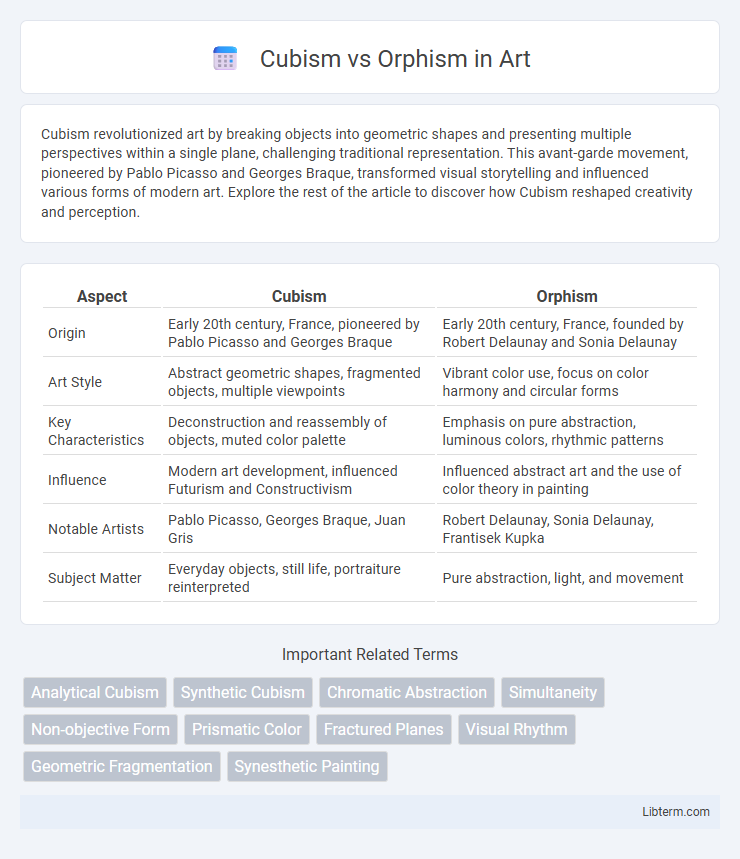Cubism revolutionized art by breaking objects into geometric shapes and presenting multiple perspectives within a single plane, challenging traditional representation. This avant-garde movement, pioneered by Pablo Picasso and Georges Braque, transformed visual storytelling and influenced various forms of modern art. Explore the rest of the article to discover how Cubism reshaped creativity and perception.
Table of Comparison
| Aspect | Cubism | Orphism |
|---|---|---|
| Origin | Early 20th century, France, pioneered by Pablo Picasso and Georges Braque | Early 20th century, France, founded by Robert Delaunay and Sonia Delaunay |
| Art Style | Abstract geometric shapes, fragmented objects, multiple viewpoints | Vibrant color use, focus on color harmony and circular forms |
| Key Characteristics | Deconstruction and reassembly of objects, muted color palette | Emphasis on pure abstraction, luminous colors, rhythmic patterns |
| Influence | Modern art development, influenced Futurism and Constructivism | Influenced abstract art and the use of color theory in painting |
| Notable Artists | Pablo Picasso, Georges Braque, Juan Gris | Robert Delaunay, Sonia Delaunay, Frantisek Kupka |
| Subject Matter | Everyday objects, still life, portraiture reinterpreted | Pure abstraction, light, and movement |
Introduction to Cubism and Orphism
Cubism, pioneered by Pablo Picasso and Georges Braque in the early 20th century, revolutionized art by breaking objects into geometric shapes and presenting multiple perspectives simultaneously, emphasizing fragmented forms and monochromatic palettes. Orphism, developed by Robert Delaunay and Sonia Delaunay, evolved from Cubism by incorporating vibrant colors and abstract circular forms, focusing on the lyrical use of color and light to evoke musicality and rhythm. Both movements significantly influenced modern art, with Cubism emphasizing structural analysis and Orphism prioritizing color harmony and sensory experience.
Historical Context and Origins
Cubism emerged in the early 20th century, pioneered by Pablo Picasso and Georges Braque, characterized by fragmented objects and multiple perspectives reflecting the influence of African art and Paul Cezanne. Orphism, developed by Robert and Sonia Delaunay around 1912, evolved from Cubism but emphasized vibrant colors and abstraction inspired by simultaneity and the urban modern experience. Both movements originated amid rapid industrialization and shifting artistic paradigms, reacting to traditional representation and seeking new ways to depict reality.
Key Artists and Influential Figures
Cubism, pioneered by Pablo Picasso and Georges Braque, emphasized fragmented forms and multiple perspectives to deconstruct objects, while Orphism, led by Robert Delaunay and Sonia Delaunay, focused on vibrant color and abstract circular forms to evoke musicality and rhythm. Key Cubist artists like Juan Gris and Fernand Leger further explored geometric shapes and monochromatic palettes, contrasting with Orphism's use of bright hues and lyrical abstraction. Both movements significantly influenced modern art by challenging traditional representation and expanding the boundaries of visual expression.
Core Philosophies and Intentions
Cubism emphasizes fragmented perspectives and geometric forms to depict subjects from multiple viewpoints, challenging traditional representation of space and time. Orphism, emerging from Cubism, prioritizes vibrant color and lyrical abstraction to evoke musical harmony and emotional experience through pure form. Both movements seek to break from realism but diverge in their focus on structural analysis versus chromatic expression.
Stylistic Features of Cubism
Cubism is characterized by fragmented, geometric shapes and multiple perspectives within a single plane, breaking objects into abstracted forms that emphasize structural complexity. It often employs monochromatic color palettes, focusing on form and spatial relationships rather than color to depict subjects in a deconstructed manner. Pioneered by artists like Pablo Picasso and Georges Braque, Cubism challenges traditional representation by presenting subjects simultaneously from different viewpoints.
Distinctive Traits of Orphism
Orphism is characterized by its vibrant use of color and lyrical abstraction, emphasizing rhythmic, circular forms to convey musicality and emotion. Unlike Cubism's fragmented geometric shapes and subdued palette, Orphism prioritizes luminosity and fluidity to evoke dynamic movement. This distinct approach foregrounds the synthesis of color and form, aiming to transcend representational art through pure visual sensations.
Differences in Use of Color and Light
Cubism emphasizes muted, monochromatic palettes with limited use of color to focus on form and structure, often employing shades of brown, gray, and black to depict fragmented objects. Orphism, by contrast, embraces vibrant, prismatic colors and dynamic light effects to create abstract compositions that express rhythm and movement. The interplay of light in Orphism enhances chromatic intensity, while Cubism's restrained color scheme emphasizes geometric analysis and spatial relationships.
Impact on Modern Art Movements
Cubism fundamentally transformed modern art by deconstructing objects into geometric shapes and multiple perspectives, influencing movements such as Futurism, Constructivism, and Abstract Expressionism through its emphasis on fragmented form and spatial complexity. Orphism expanded on Cubist principles by introducing vibrant, pure colors and lyrical abstraction, pioneering color theory's role in modern art and impacting movements like Fauvism and Abstract Art. Both movements collectively reshaped artistic expression by challenging traditional representation and promoting innovative approaches to form and color in the 20th century.
Critical Reception and Legacy
Cubism, pioneered by Pablo Picasso and Georges Braque, received widespread critical acclaim for its revolutionary approach to fragmented perspectives and abstract forms, profoundly influencing 20th-century art movements. Orphism, founded by Robert Delaunay and Sonia Delaunay, gained recognition for its vibrant color theory and lyrical abstraction, positioning itself as a bridge between Cubism and Fauvism. Both movements significantly shaped modernist aesthetics, with Cubism laying the groundwork for abstract expressionism and Orphism advancing the use of color as an autonomous structural element in painting.
Conclusion: Lasting Influence and Comparison
Cubism revolutionized visual perception by fragmenting objects into geometric shapes, profoundly influencing modern art movements such as Futurism and Constructivism. Orphism, emerging as an offshoot of Cubism, emphasized vibrant color and lyrical abstraction, paving the way for later developments in abstract art and color theory. Both movements significantly shaped 20th-century art, with Cubism's structural innovation and Orphism's chromatic experimentation leaving enduring legacies in artistic expression.
Cubism Infographic

 libterm.com
libterm.com